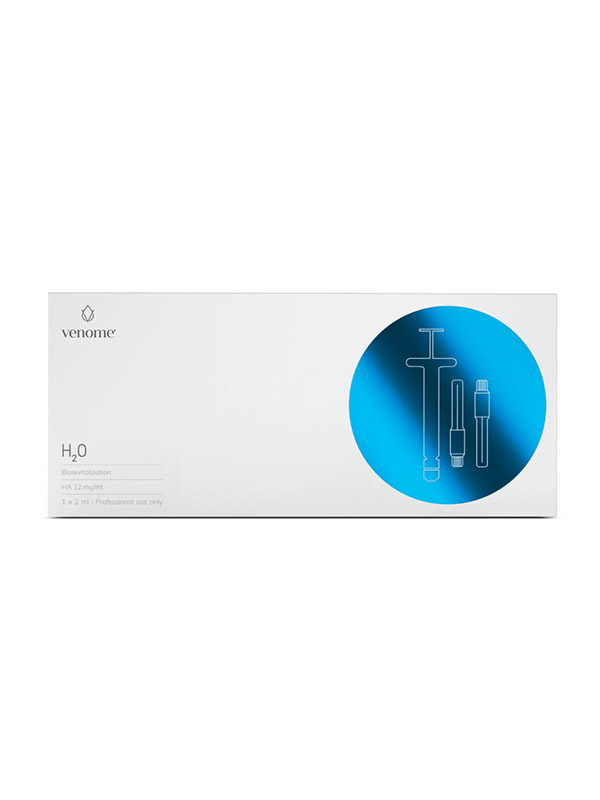Venome H2O
Venome H2O - an innovative stimulating treatment based on innovative high molecular weight hyaluronic acid at a 12 mg/1ml concentration, which has exceptional regenerating properties and helps restore volume and hydrate tissues. The product improves water balance in the extracellular matrix and stimulates fibroblasts to intensively produce new protein fibers in the skin, which means it can restore its density and firmness. The product has a class III medical certificate.
Venome H2O is based on innovative hyaluronic acid with exceptional stimulating properties: it can effectively activate the CD44 receptor on fibroblasts, which results in accelerated metabolism and improved cell performance. The CD44 protein is one of the main receptors for hyaluronic acid and can be found on the surface of fibroblasts. It is truly unique, as it can control and transmit the right signals inside the cell, contributing to its quicker growth, proliferation, and intense production of type III collagen - also known as "young collagen".
CONTRAINDICATIONS AND SIDE EFFECTS VENOME H2O
Contraindications
Venome Biorevitalization H2O is contraindicated in case of:
- allergy to hyaluronic acid
- auto-immune disease or during immunotherapy
- acute skin infection in the area to be treated (e.g. acne)
- acute influenza and feverish cold
- acute systemic infection (herpes, psoriasis)
- coagulation disorder
- a tendency to form scars
- pregnancy or breast-feeding
- people under age of 18
Venome Biorevitalization H2O must not be injected into:
- blood vessels
- bone joints
- breasts
Side effects
Immediately after treatment, injection related reactions like redness and swelling and in rare cases itching or bruising may be observed at the injection sites. Allergic reactions are extremely rare because Venome Biorevitalization H2O is protein free due to the non-animal source. Injection-related reactions will dissolve spontaneously within a short while.
In case of an inflammatory reaction it is recommended that the patient visit the physician.
In literature, individual cases of granuloma, abscesses, discolouration and necrosis have been described.
Revitalizing H2O gel effectively reduces skin aging symptoms by improving skin hydration, which helps restore a healthy environment for fibroblasts to work. Owing to the use of hyaluronic acid fragments with the capacity to activate CD44 receptors, new collagen fibers are produced much more quickly, which in turn helps the skin recover its firmness and density. As a result, its structure improves and persistent and expression wrinkles are minimized.
- visibly loose skin
- loss of hydration
- persistent wrinkles
- prominent jowls
- loss of skin elasticity
- lack of glow
Venome H2O can be administered using several methods: bolus, linear retrograde, or 5-point. In each technique, the product must be applied into the dermis, 1,6-2,2 mm deep.
The bolus technique involves the administration of deposits into the dermis all over the face or just in the areas in particular need of stimulation.
The linear retrograde technique involves administering the product into the dermis, along the folds and wrinkles, to stimulate the skin in those areas.
In the 5-point technique, the needle is inserted perpendicularly into deep layers of the dermis, leaving deposits of 0.2 ml in each point. Five points are selected on the two sides of the face. These points are anatomically safe.
Point 1 – 2 cm down from the external corner of the eye on a line connecting it with the angle of the mandible
Point 2 - 1 cm laterally from the ala of the nose
Point 3 - 1 cm in a straight line from ear cartilage
Point 4 - 2 cm down and 1 cm medially from a downwards line starting at the external corner of the vermilion zone
Point 5 - 1.5 cm medially and upwards from the jaw line


Dermedica Drug Store LLC proudly serves as the authorized distributors for Venome Global and Love Cosmedical in Dubai, UAE
view all products